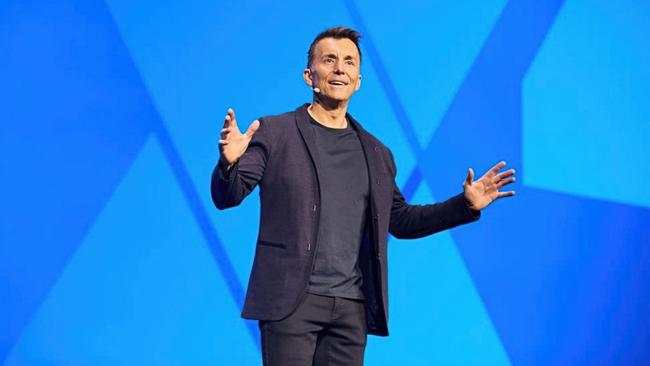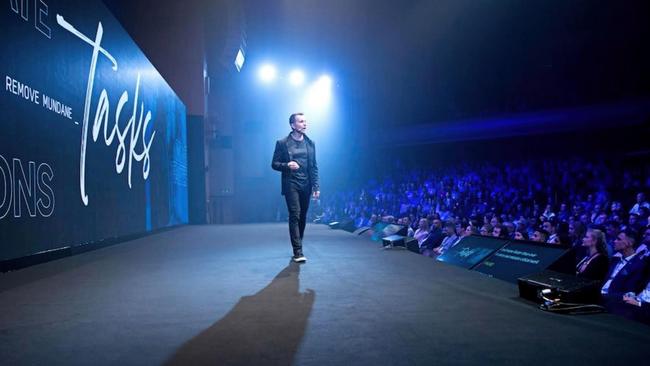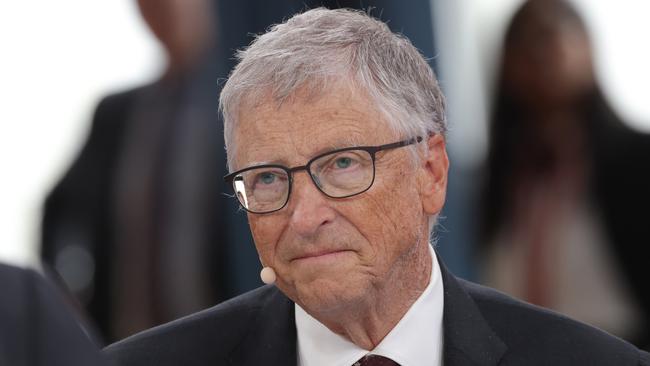How this tech titan is using machines to make business more human
Family tragedy moulded Qualtrics chief Zig Serafin into who he is today but it was a 17-year career with Microsoft which fired his passion for AI to enhance personal experiences in businesses.

Qualtrics boss Zig Serafin has unpleasant memories of the day he was asked to step out of his fifth grade classroom to visit the principal’s office at his primary school in San Diego.
When he arrived there, the message was simple: a family friend would be picking him up from school that day. Later, he found out why.
Across town his father, Stanley, had died after a long battle with respiratory disease.
Zig was only 10 years old. He still remembers the last time he saw his father lying in a hospital bed. But he never got the chance to say goodbye.
“There was a series of multiple health incidents that he had over several years. So it wasn’t a substantial surprise. But nevertheless, it was hard. It was a shock. That was a shock for a long time,” he now recalls.
He was the eldest of four boys. His mother, Tina, like his father was an immigrant from Poland who landed in America unable to speak a word of English, and was left to bring them up on her own.
From an early age the Polish-speaking Serafin discovered the importance of focus, education, discipline and empathy as he learned to speak English alongside his parents. But what he gleaned from his mum in the years after losing his dad was priceless.
“Dad’s passing was a moment of hardship, trial and uncertainty. Then I watched my mother and how she pulled things together and figured out a way to have life move forward,” he says.
“I watched her work hard to take care of the family. I watched the example of how she just stepped up as a leader in moments like that. That now fuels the way I approach tackling problems and challenges in different circumstances.”
Those experiences have been fundamental in shaping his leadership style at Qualtrics International – the global technology firm taken private off the Nasdaq last year in a $US12.5bn takeover by private equity giant Silver Lake and the Canada Pension Plan Investment Board (CPPIB).
Serafin moved to Utah to join Qualtrics in 2016 as chief operating officer after 17 years at Microsoft, where he led the team that created what is now known as Microsoft Teams.
He stepped into the Qualtrics chief executive role in July 2020, replacing longtime CEO Ryan Smith, who co-founded the company in Salt Lake City in 2002 with his brother, Jared, and father Scott.
In 2019 the firm was acquired by German software giant SAP for $US8bn, before it was listed on the Nasdaq in 2021 and then taken private.
Despite leading Qualtrics through several ownership iterations, Serafin has never forgotten the lessons of his youth.
He recalls his father regularly asking him after school to help plant fruit trees – everything from avocados to guavas, peaches and nectarines – outside their home on a small piece of land near San Diego.
The subsequent crop fed the family for years.
“We learned what it takes to take care of something and harvest from it,” he recalls.

He took his first job after his father’s death collecting weeds and cleaning neighbours’ yards, determined to help support his family and be a role model for his younger brothers.
He also watched his mother, who was a teacher in Poland but whose qualifications meant nothing in America, work as a janitor during the day at UCLA Hospital while she studied in the evenings to become a nurse.
After getting her nursing qualifications, she eventually became a home healthcare practitioner.
“One of the teaching moments for me, that I try to carry with me today, is the level of care and attention she was able to take to the people that she cared for in their homes,” he says.
“Because you better understand people in a much fuller way when you are in their homes. You build a real connection.
“At Qualtrics we partner with some of the leading healthcare organisations around the world today. Many want to be in a position where they develop a relationship in a context similar to what my mother was able to do.
“What healthcare organisation does not want to build that level of relationship? Because if you understand the experiences that matter to them the most, that usually leads to better outcomes for that person.”
Early influences
It was Serafin’s stepfather, Richard, who introduced him to the sharemarket and the world of public companies before he was a teenager.
Richard was legally blind, a legacy of fireworks exploding in front of his eyes in his younger years.
So he would regularly ask his stepson to read him the finance pages of the newspaper.
“He would ask me for the price of Berkshire Hathaway stock, and if I remember, around that time it was about a $5000 per share,” Serafin says.
“I remember the conversation with him when he said ‘Well, that’s a very expensive share’ and he told me the real meaning of the share price. As a young kid, some of that went right over my head but some of it made me more curious.”
After leaving school a year before his graduation, Serafin worked for several family businesses before scoring a night job at US postal giant UPS.
But it was an internship in the early 1990s in the marketing department of the private bank of Wells Fargo in downtown San Francisco that first introduced him to the technology sector – and he never looked back.
On his fifth day in the job at Microsoft, at the age of 28, he remembers being called into a “review meeting” with the firm’s superstar founder, Bill Gates.
“Bill’s characteristics are very much like how some people have described him: very driven, very actively focused. He had his yellow notepad and he was sketching and writing notes as topics were being described,” Serafin recalls.
“But he was also not afraid of lifting his head up and very directly attacking the problem and debating the heck out of it, to really net out and synthesise the core issue that was being described.

“You could see the passion and love for what he was working on. You could also see his impatience with stupid ideas. The people that were in the room weren’t afraid of challenging that. So it made for a lively entree.”
In his 17-year career at Microsoft, Serafin served as corporate vice-president of program management and design for its services in anticipatory computing, speech/audio/vision processing, location/language understanding, and geospatial data. He led the teams that developed Microsoft’s artificial intelligence platform.
Asked what was his greatest lesson from his time there, he replies without hesitation:
“Scale.”
“How to design platforms that can touch hundreds of millions of people. Both from a business model standpoint, as well as from a technology perspective,” he says.
“The combination of those two factors is something Microsoft has uniquely done.”
Serafin’s passion for human connection has long underpinned his curiosity for a human-centred approach to technology and the importance of bridging the gap between people and machines to create better experiences for everyone.
It was his vision for bettering the human experience which drew him to Qualtrics in 2016 and then drove the creation and launch of the so-called “experience management” category of technology.
“Human connection is the foundation of great experiences. So the deeper the connection that a business or an organisation can make with human beings to understand what they are thinking and feeling about the way that they engage with the firm – no matter what sector or part of the world that you are in – is fundamental to creating great experiences,” he says.
“If you understand what great experiences might look like at scale, chances are you will probably be one of the best leaders in that marketplace.”
Unlocking AI’s potential
Today, Serafin’s focus is on using AI to help Qualtrics’ 20,000 customers better understand and deliver against the needs of their customers and employees, capturing feedback at every point of interaction.
He believes customer and employee experience is critical to unlocking AI’s potential and ensuring organisations realise the full scope and benefit of their own data.
Last year, Qualtrics committed to spend $US500m on AI innovation over four years to better understand human emotions, beliefs, sentiments and values – and to help brands close the experience gap with their customers.
In May it launched Qualtrics Assist, an AI agent that helps staff in a company get deep and actionable insights into their customers and employee experiences by asking natural language questions and gathering feedback through an interactive dashboard.
The AI can then trigger actions and workflows.
This week Utah-based Serafin visited Sydney to deliver the keynote address at Qualtrics’ X4 customer conference, which drew 2000 experience and employee experience leaders.
Qualtrics’ Australian customers, including Hilton, Flight Centre, Xero, Cochlear, DoorDash, Endeavour Group, Atlassian, AustralianSuper and the Australian Digital Health Agency, spoke of how the global tech giant helps them drive better business outcomes and growth.
Going forward, Serafin envisages virtual personal assistants powered by AI assisting consumers to interact with brands in real time.
“This would be right in the moment when you need it. Whether that is custom tailoring the product that you like and enabling the preferences, to better enabling how you consume that product and how it’s delivered,” he says.
“It would be a level of intelligence and capability that helps an organisation do that for every single one of their customers at scale.”
Qualtrics hasn’t been immune to the challenges facing the big global tech firms which grew quickly and often unsustainably during the Covid-19 pandemic.
In October last year it announced plans to cut 780 roles across the company, or 14 per cent of its workforce.
“One of the most important parts of the job of the management team is to make sure you’ve got the company set up with the right people in the right places, focused on some of the hardest problems,” Serafin says of the cuts.
Curiously his corporate side hustle for the past three years has been as a director of global credit ratings giant Moody’s, which has shown him how data and insights are used to help risk management and decision-making in companies.
Serafin has been married to wife Ashley for 25 years. He describes her as a “saint” for her nurturing and care of their family. They have five children who they moved to Salt Lake City in 2017.
Since then one of their daughters, Nina, has been outspoken about climate change and led a number of clean energy and waste management initiatives in the city.
“She has, just like I do, a very deep care for the health of the environment and what it takes to be able to sustain this beautiful world that we live in,” her father says.
One of the most special moments of his eight years at Qualtrics was a visit to the Polish city of Krakow, where the firm has an operating centre.
It is only a short drive from the small farm where his mother grew up. Their family was poor and lived there in a cabin with a dirt floor.
“There she learned hard work, what it means to be patient and what it means to be of service to other people. That sort of leadership mindset has been embedded in how I look at working with people,” Serafin says.
She is still alive, in good health, and living comfortably in America, proud of having shaped her eldest son into the corporate leader he is today.
Serafin’s dreams of his father doing the same were dashed more than four decades ago.
Asked what he would say to his dad if he were alive today, he simply repeats an impossible dream: “I just wish he was around for a lot longer.”




To join the conversation, please log in. Don't have an account? Register
Join the conversation, you are commenting as Logout